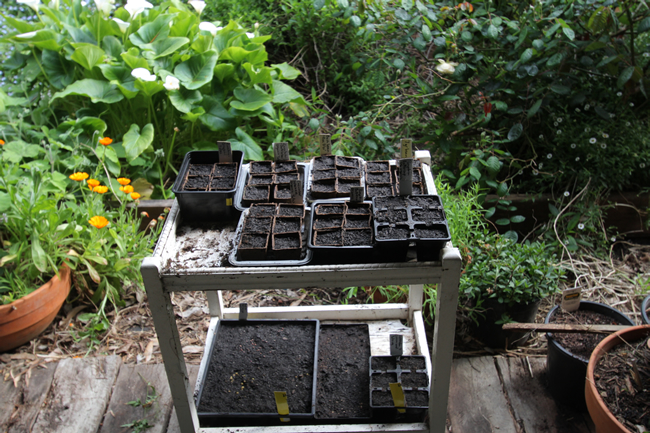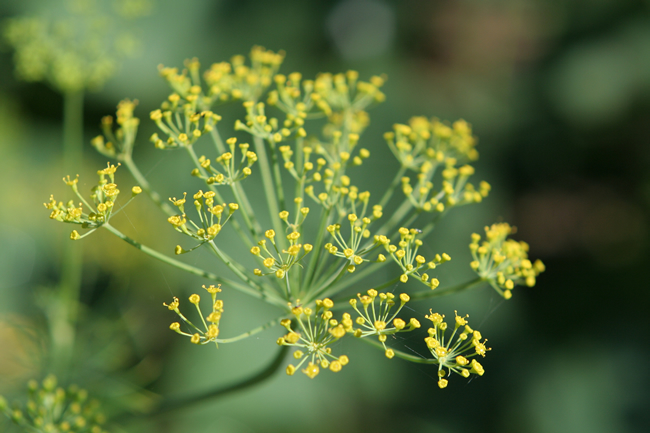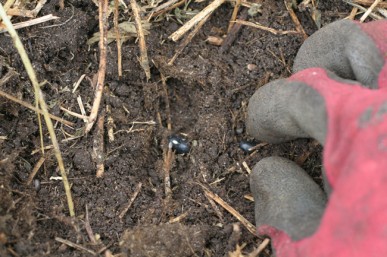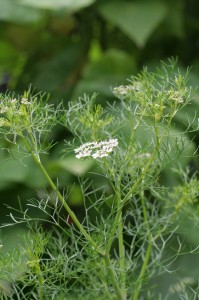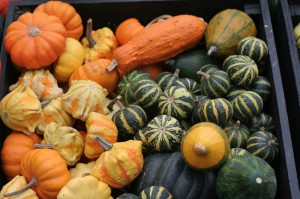I’ve had great fun over the last few weeks planting seed and watching them come up. I love the fact that more and more now it is possible to buy organic seed. This means that not only are my plants grown organically, but they are organic right from the beginning. I would urge everyone to support the seed suppliers who sell organic seed. There are many small suppliers and bigger suppliers who are now sourcing and selling Organic Seeds (see the list at the end of the article). Read more
Dill, Anethum graveolens, is a delightful tall annual herb that grows to about 1 m from a taproot, with a single stem and many feathery blue-green leaves and branches. These are topped by groups of umbrella-shaped flower heads made up of small yellow flowers. The flowers are followed by flat, oval, brown seeds, which self-sow readily if left on the plant. Dill is probably one of the oldest medicinal herbs. It was used by the Egyptians before 3000 BC. The name dill is found in several old European languages, reflecting its widespread use, but its derivation is unclear. In medieval times, dill developed a reputation for protecting anyone who carried it against witches. It was a common ingredient in potions and spells and English country brides would wear a sprig of dill on their wedding day, while in Germany, a bride would put dill and salt in her shoes to bring her good luck. By the beginning of the seventeenth century dill was grown in many countries all over the world because it was known as ‘a gallant expeller of wind’. Read more
Beans are a very rewarding crop and relatively easy to grow. I love them because they don’t take up much space but within a few weeks you can harvest an abundance of crisp, flavoursome beans. Soak seeds overnight to increase the speed of germination. Just put the seeds you want to plant into a bowl and cover with water. The next morning, water the soil where you are going to put the beans and plant seeds two at a time pushing them about 4cm into the soil. I always plant two because often one will not grow. Cover with soil but don’t water as the soil and the seeds are already wet. If you don’t soak the seeds then you will need to water. Leave about 20cm between plants if they are dwarf forms, or 15cm if they are climbers.
Coriander, also known as cilantro and Chinese parsley, is one of the most ancient herbs still in use today. It is also claimed by some to be the world’s most widely used herb. Whether this is true or not, coriander leaves and seeds are essential to the cuisine of central and southern America, South-East and northern Asia as well as India and the Middle East.
History
Coriander comes originally from southern Europe where the seeds have been used for centuries, but the leaves were not usually used. Coriander seeds have been found in Egyptian tombs dating from more than 3000 years ago. The Egyptians cultivated coriander in their gardens and offered it at funeral ceremonies. It was used by Hippocrates and other Greek physicians as early as the fifth century B. C., while the Chinese considered that coriander had the ability to bestow immortality. This plant has the distinction of being one of the few herbs mentioned in the Old Testament Num. 11:7
“Now the manna was like coriander seed.”
The botanical and common name, coriander, comes from the Greek word koris which means ‘bug’. This presumably relates to the fact that the smell and flavour of coriander has been unfavourably compared with that of stink bugs. Read more
Last weekend saw a celebration of old cultivars and varieties of both fruit and vegetables. At Diggers Heronswood, Dromana it has been the Harvest Festival Weekend with a really beautiful array of pumpkins and squashes, garlic for sale and tomatoes to taste. Nearly all of these are heirloom or open pollinated varieties that are so important both for our gardening history and our future. Heirloom and heritage varieties are an integral part of organic gardening, many are the result of selective breeding over numerous generations so that they show special characteristics.
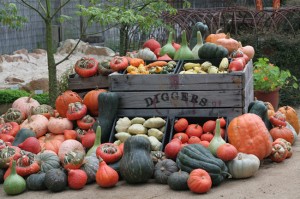
Turk's Turban, Delicata, Potimarron, Australian Butter, Buttercup and Bohemian are just a few of the heirloom varieties of pumpkins available to grow.

